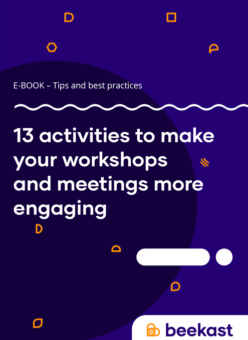You’re planning a work meeting and you want to stimulate collaborative, effective discussion with your team members?
Make sure you have everything you need to create interaction and value and gather feedback during this time together.
Planning a work meeting: the essentials
This checklist will enable you to plan effective team meetings.
1. Define the meeting goals
To lead a meeting effectively, you must first decide on the goal to be achieved.
Determine whether the purpose is to:
- share a vision
- initiate discussion
- present an overview
- solve problems
- prioritise and decide together
- explore and reflect together
- wrap up discussion
The goal of the meeting will help you identify the most suitable type of meeting.
2. Draw up the agenda
The meeting agenda allows you to identify and communicate the various points to be discussed during your meeting. It also serves as a follow-up plan for discussions and as a programme to structure them.
This is your go-to document for hosting an effective meeting. It sets out the order of the themes to be addressed, according to priority.
This document enables participants to identify the points that concern them ahead of time, so that they can prepare their contribution and initiate discussion.
Without an agenda, participants have no structure for discussion and may not meet the expected meeting goal.
Is the agenda too long? This is an opportunity for several short meetings instead of one long one.
3. Identify participants and define their role during the meeting
Who needs to attend your work meeting? How many participants will there be?
Meet with the people who can truly help move the agenda forward and achieve the meeting goal.
For really effective meeting leadership, assign a specific role to each participant.
- Facilitator: the meeting coordinator. This person must make participation active and balanced to help discussions move forward.
- Time keeper: assists the facilitator by indicating the time remaining for each item on the agenda.
- Decision tracker: pushes the team to make decisions and writes them down for the record. This person is in charge of recording decisions.
- Recorder: takes notes during the meeting to write up and share the report.
- Participant (each meeting attendee): contributes to collective intelligence to help move discussions forward by sharing ideas and building on input from others.
4. Schedule the meeting
When is the best time to schedule your meeting?
It is advisable to schedule meetings at the beginning or end of the half-day to avoid interrupting operational tasks in the middle.
Again, it all depends on the type of meeting.
Try to schedule highly strategic meetings in the morning, when ideas are still fresh. This applies to brainstorming sessions for example.
Finally, remember to check the availability of the meeting participants and location. The more welcoming the meeting room and environment is, the more effective the meeting will be.
5. Prepare your meeting tools
What are the essential materials and documents for an effective work meeting?
- your presentation materials
- a flip-chart
- a video projector and screen
- interactive activities to encourage discussion
- digital board for in-person or remote brainstorming
- collaborative tools for working remotely
6. Remember your meeting report
Don’t leave the meeting without writing down the decisions and creating an action plan with your teams.
The report is your post-meeting follow-up document.
Be sure to identify the person in charge of the meeting report (the recorder) and define the framework beforehand.
The recorder will then be required to share it with participants at the end of the meeting.
That’s it! Now you’re ready to host your next meeting.




